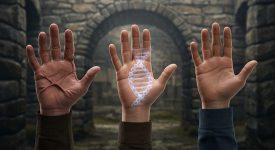
Dupuytren’s Disease and Genetics: What Family History Tells Us
Dupuytren’s Disease and Genetics: What Family History Tells Us
Introduction for genetics
If your father or grandfather had bent fingers from Dupuytren’s Disease, you might wonder if you’re destined to develop it too. Genetics play a major role in Dupuytren’s disease—so much so that it’s often called the “Viking disease” due to its prevalence in people of Northern European descent. While lifestyle and environmental factors can influence how the condition develops, family history is one of the strongest predictors.
Genetic Studies
Large genome-wide association studies (GWAS) have identified multiple DNA regions linked to Dupuytren’s. Many of these regions affect genes involved in collagen metabolism, wound healing, and tissue repair, which explains why abnormal scar-like tissue can form in the palm. These studies continue to uncover more genetic signals, suggesting that Dupuytren’s is not caused by a single gene, but by a combination of many small genetic changes working together.
Family Risk
Having a first-degree relative with Dupuytren’s disease roughly doubles or even triples your risk compared to the general population. Families with several affected members often see the condition develop earlier and progress more quickly. This pattern shows how genetic load—the accumulation of multiple risk genes—can strongly influence disease severity.
Why This Matters
Understanding the genetic background of Dupuytren’s disease can help explain why the condition looks different from person to person. Some may only develop mild nodules, while others experience rapid progression and finger contractures. Knowing your family history can also help you and your doctor monitor symptoms earlier, making timely treatment more effective.
What This Means for Patients
Family history cannot predict exactly when Dupuytren’s will appear, but it raises awareness. Patients with family risk should monitor early signs closely and consider preventative strategies.
What the Science Says
Studies in Iceland, the UK, and the Netherlands consistently show heritability. One study found 80% of Dupuytren’s risk is genetic. However, environment (smoking, alcohol, diabetes) also modifies disease course.
Connections to Dupuytren’s
For patients with family history, early detection is key. Talk to your doctor if you notice palm nodules or cords, even if they seem mild. Awareness empowers you to act sooner rather than later.
Key Takeaways
- Strong hereditary link: family history increases risk.
- Genes control collagen remodeling.
- Environment still matters: lifestyle can slow or speed progression.
- Early detection helps: family history should prompt earlier screening.
Attribution
Attribution (CC BY 3.0): Adapted from Dolmans GH, et al. Common Variants in the WNT Pathway Influence Dupuytren’s Disease Susceptibility. PLoS Genet. 2011;7(12):e1002361. Licensed under Creative Commons Attribution 3.0.
For the complete article and reference list, click Source.
Call to Action
Call to Action: If Dupuytren’s runs in your family, take action now. Visit https://www.dupuytrensolutions.com and join the conversation at https://www.facebook.com/groups/dupuytrensolutionsandhealth.


